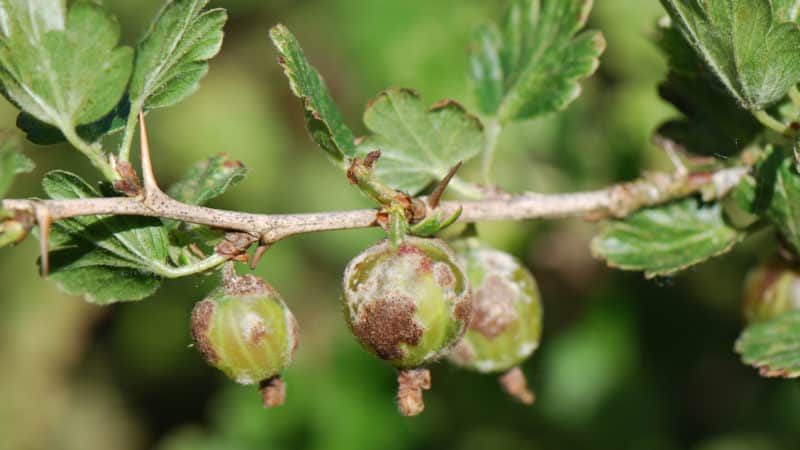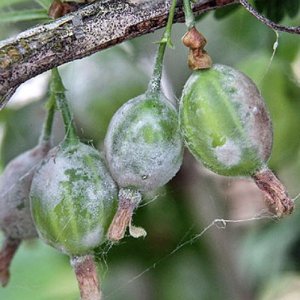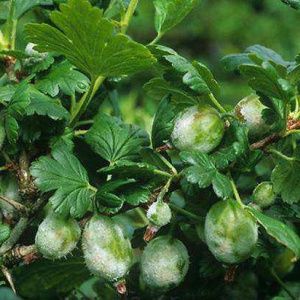Powdery mildew on gooseberries: signs, causes, control measures, prevention
Powdery mildew (spheroteca) is one of the most common diseases of gooseberries. The infection is caused by a fungus of the same name. It is because of powdery mildew that gooseberries most often die.
The disease leads to shedding of leaves, stunting of growth, deformation and drying out of shoots, decreased winter hardiness of the bush and ultimately to its death. Despite the fact that the disease is very dangerous, it can be cured, especially if noticed in the initial stages of development. Various control measures are used. The fungus is removed using chemicals and folk remedies.
Signs of powdery mildew
The appearance of powdery mildew is usually expected in the spring, as during this period there is high humidity and low temperature. Possible defeat gooseberries and in summer.
To save gooseberries, it is important to recognize the disease in a timely manner. This is not difficult to do, since the signs of powdery mildew are specific:
- First of all, the fungus attacks the lower part of the bush. A loose whitish coating forms on the leaves and shoots. It is dry to the touch and resembles flour, but does not crumble when the wind blows or the plant is shaken. If you rub the affected area with your finger, you can erase the white residue.
- The defeat spreads throughout the bush. The upper leaves and shoots turn white. In the end disease spreads to ovaries or fruits. The whole bush looks dusted with flour.
- The plaque becomes denser and is not erased with a finger.Then it acquires a gray or brown tint.
- Affected berries become deformed, become smaller and dry out.
- The leaves curl, dry out and fall off. The shoots become deformed and stop developing.

Photosynthesis is disrupted in affected plants. The bush becomes weak and does not tolerate negative environmental factors and winter cold. As a result, the gooseberry dies.
Note! Powdery mildew spreads quickly throughout the garden. It affects not only gooseberries, but also currants, honeysuckle and other fruit and berry crops.
Causes of the disease
Powdery mildew fungus overwinters in the soil, on fallen leaves and other plant debris. Its development is provoked by the following factors:
- High humidity in warm weather. That is why the disease usually affects the plant in the spring, in early May.
- Fluid stagnation. This is facilitated by excessively frequent and abundant watering and lack of loosening of the soil.
- Favorable conditions for wintering. They are created by the gardener, leaving fallen leaves, tops of cultivated plants and weeds on the site in the fall.
- Densified plantings contribute to disruption of air exchange, creating favorable conditions for the development of fungus.
- No sanitary pruning. Too thick a crown prevents normal air exchange. Sanitary pruning is carried out in order to promptly identify and remove branches affected by infection.
- No weeding. Weeds are carriers of fungus.
- Pests spread fungal and viral infections.
- Lingering rains. After prolonged cloudy weather, the risk of plant infection increases significantly.
Not all of the factors described can be influenced by the gardener.Those that a person can eliminate are given special attention, including to avoid re-infection.
This is interesting! Powdery mildew is often called American mildew. It is believed that it was brought to our country from America.
Measures to combat powdery mildew on gooseberries
The earlier the disease is noticed, the easier it is to get rid of it. If the plaque has already acquired a gray or brown color, it will take longer to treat the gooseberries.
The fungus releases spores in spring and summer. Therefore, the plant is treated at least 3 times a year, even if the signs of the disease have disappeared after the first spraying.
When to treat gooseberries for powdery mildew:
- before flowering begins;
- after flowering;
- after leaf fall.
It is possible to get rid of the disease even in advanced stages. In the early stages, chemicals are not needed; in this case, folk remedies are used.
Before starting to treat the disease, remove all affected leaves and shoots. They are taken away from the site and burned. After this, the plants are sprayed.
It is important to process the gooseberries generously so that all parts are covered with a thick layer of product. Particular attention is paid to the inside of the leaves.
Folk remedies
Folk remedies are effective in treating gooseberries when signs of the disease just appear. Such preparations do not contain chemicals and are therefore considered safe for humans and the environment. After using them, there is no risk of poisoning from the berries; they are allowed to be used even during the fruiting period.
There are many folk remedies that can remove the fungus that causes powdery mildew on gooseberries. Below we will talk about the most effective of them:
- Soda, aspirin, soap and oil. 2 tbsp. l.soda, 4 aspirin tablets, ¼ piece of laundry soap, grated, and 2 tbsp. l. vegetable oil is diluted in a bucket of water.

- Ash with soap. A 10 liter bucket is filled with 2 kg of ash and 1 piece of grated laundry soap. The product is allowed to brew for two days, after which it is mixed and sprayed on the plants.
- Soda ash with soap. 0.5 pieces of laundry soap (preferably dark) are grated and poured into a 10 liter bucket of water. Add 50 g of soda ash to it. The remaining volume is diluted with hot water. The ingredients are mixed until dissolved. The preparation is allowed to cool to room temperature, after which the gooseberries are processed.
- Sour milk, whey or kefir. 2 liters of dairy product are diluted with 8 liters of water. To enhance the effect, add 30 drops of iodine to the product.
- Mullein. 1 kg of mullein is added to 3 liters of water. The product is allowed to brew for three days, after which 12 liters of liquid are diluted. The resulting preparation is sprayed on gooseberries.
- Onion and garlic peels. 0.5 kg of onion peels and 200 g of garlic peelings are poured into 10 liters of boiling water. The product is allowed to brew for 4 days.
- Tansy. 0.5 cups of dry tansy pour 10 liters of boiling water. The product is infused for 24 hours, then boiled for 2 hours over low heat, filtered.
- Spruce needles. The bucket is filled one third full with spruce needles. The rest of the volume is topped up with boiling water. The product is allowed to brew for three days. Then filter and add 0.5 pieces of laundry soap.
- Horsetail 1 kg of horsetail is poured into 3 liters of water and boiled for 2 hours. The decoction along with horsetail is poured into a 10 liter bucket of water, the rest of the volume is topped up with water at room temperature. The product is infused for 2 days.
- Milk with soda. Pour 1 liter of milk into a 10 liter bucket and add 0.5 kg of soda.Pour the ingredients with water and stir until the soda is completely dissolved.
- Zelenka. Dissolve 20 drops of brilliant green in a bucket of water.
- Ammonia and cinnamon. 100 mg of ammonia is poured into a bucket of water and 20 g of cinnamon is added. Let the product brew for 4 hours, then stir and use to spray gooseberries.
Using folk remedies, gooseberries with powdery mildew are sprayed 1-2 times a week until the problem is eliminated. They are also used after long rains, even if the plant has not become sick. Treatments are required before and after flowering, as well as after leaf fall.
Spray the entire bush, including the inside of the leaves. In addition, solutions are used to water the soil around the plants. Before this, all weeds are removed and the soil is loosened.
The treatment is carried out in dry weather when the sun is inactive. Otherwise, the product will be washed off by rain.
Advice. It is recommended to spray not only the diseased plant, but also the fruit and berry bushes growing next to it.
Biological products
If the plant already has ovaries and full-fledged berries, biological preparations are used. They are washed off with water, do not harm the environment and do not pose a threat to human health. The last treatment is done no later than 10 days before harvest.
The most popular biological products:
- "Fitosporin". The preparation is not only sprayed on all parts of the bush, but also the soil underneath it is watered. Gooseberries are treated with the product every 2 weeks.
- "Alirin-B". The product destroys fungus and removes nitrates from the plant. It is believed to increase the amount of vitamin C in the berries. They treat plants and the soil around them.
Chemical substances
If powdery mildew has managed to affect most of the bush, folk remedies may be ineffective.Then chemicals are used. They not only destroy the fungus, but also prevent its reappearance.
The disadvantage of chemicals is that they have a negative impact on the environment and human health. If the gooseberries were processed during flowering or fruiting, the berries are dangerous to eat.
Next, we’ll tell you how to fight powdery mildew on gooseberries using chemicals:
- "Raek" – an emulsion, the active substance of which interferes with the synthesis processes in the cells of the fungus, stops its growth and prevents the formation of mycelium. This drug with low toxicity is not washed off by rain and works for a long time. To prepare, dilute 2 ml of the drug in 10 liters of water. This amount is enough for 3-5 bushes. Treatment is carried out 4 times with an interval of 7-8 days.
- "Topaz" – one of the most effective remedies against powdery mildew. Its main active ingredient is aimed at destroying the spheroteca. Eliminates the possibility of re-infection. Destroys the fungus in 3 days and prevents re-infection for another 7 days. Does not wash off with water. To prepare a solution, dilute 6 ml of emulsion in 10 liters of water. Treat 3 times at intervals of a week.
- "Vectra". Effective against most fungal diseases. Destroys fungus, penetrates plant tissue, and prevents re-infection. Doesn't wash off in the rain. To prepare a solution, dilute 2 ml of the drug in 19 liters of water.
- "Tiovit-Jet". The active substance disrupts the vital processes of the fungus, releasing sulfur. The product is sold in powder form. It is not washed off by rain and protects the plant from re-infection for 10 days. To treat gooseberries, dilute 30-80 g of the drug in 10 liters of water.
The described fungicides have hazard class 3 and are slightly toxic to humans, animals and the environment. Processing gooseberries with them during flowering is prohibited.
Important! When working with chemicals, wear a protective mask and gloves.
Is it possible to eat the berries of a recovered plant?
Berries covered with a whitish coating look unattractive. They are unpleasant to eat, but the disease does not affect the taste.
Fruits that are not completely covered with a thin layer of plaque are washed so that no white spots remain on them and eaten.
The berries, covered with a thick layer of plaque that is not washed off, are peeled. They are used in processed form (jam, pie filling, compotes).
Attention! People prone to allergies should avoid berries contaminated with powdery mildew. Fungal spores can cause an allergic reaction.
Disease prevention
Although powdery mildew is treatable, it is not easy to remove. The disease reduces the winter hardiness of the plant, which is why the gardener will have to pay increased attention to gooseberry care and preparation for cold weather.
To avoid these problems, it is important to take preventive measures:
- Landing. The risk of infection is reduced if the gooseberries are planted in an open area of the garden. It is important that the plant receives enough sun. Another condition for prevention is planting shrubs at a distance from each other.
- Trimming. In spring or autumn, old, damaged branches, as well as shoots that thicken the crown, are pruned.
- Compliance with watering rules. The shrub is watered no more than once a week, subject to dry weather. After watering and precipitation, the soil is loosened.
- Weed removal. The area around the bush is weeded regularly.To slow down the growth of weeds, mulch the soil.
- Scalding. Most diseases can be prevented by pouring boiling water over the bushes immediately after the snow melts. It is important that hot water gets not only onto the ground around the gooseberry, but also onto its branches. If the buds have already opened, this cannot be done.
- Preventive treatment. In early May, gooseberries are sprayed with a solution of copper sulfate or “Fitosporin”.
Conclusion
Powdery mildew is a dangerous fungal disease that often affects gooseberries. It causes leaves to fall off, shoots to stop developing, deformed and fall off. berries, reduces the winter hardiness of plants and disrupts photosynthesis. Without treatment, fruit and berry bushes die.
It is possible to cure powdery mildew. For this purpose, fungicides, biological products and folk remedies are used. Safe medications will only be effective if treatment is started at the very beginning of the disease.